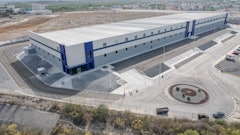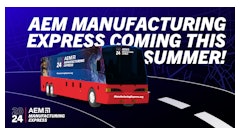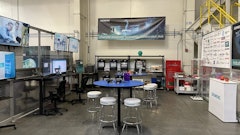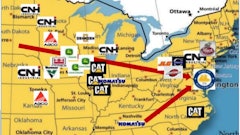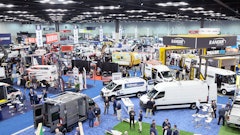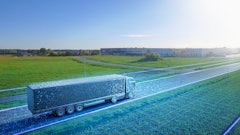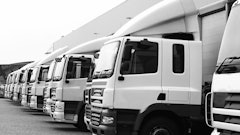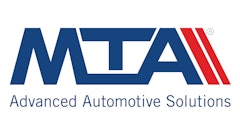In chemistry, a catalyst brings about a change, often increasing the rate of change or the reaction. In off-road equipment, one catalyst that's caused a big reaction is emissions regulations. As the requirements become more stringent with every tier, they challenge off-highway OEMs and their engineers to look for new approaches to component, system and overall equipment design. When you add in customer requests for lower operating costs and an increased ability to get more done in a day, OEM designers get creative. The new 764 high speed dozer (HSD) from John Deere and the Caterpillar D7E electric drive track-type tractor are excellent examples of innovative machines. Both were introduced at the recent ConExpo/Con-Agg show in Las Vegas.
Listening to customers
Both Deere and Caterpillar have a formal means of obtaining customer input on new equipment.
"In working with our customers through our Customer Advocate Group (CAG) process, Deere was able to identify a gap in the ability of current machine forms," Scott Bayless, product consultant for Deere, explains. The result is what Deere calls its first new machine form in decades.
According to Bayless, motor graders can work at a relatively fast speed. They are quite mobile and because of their rubber tires, disturb the finished grade very little. "There are some challenges that face a motor grader, however," he says. "They usually require a very skilled operator, they are somewhat limited to ground conditions due to a relatively high ground pressure, and they have a large turning radius limiting their ability to maneuver tight areas."
He continues, "Track crawlers have the ability to operate in a wider array of conditions due to a much lower ground pressure. They typically don't require as much skill to operate and are very maneuverable in tight areas. Their downsides are their lack of mobility, lower grading speeds, limited blade visibility and poor ride quality due to the steel undercarriage."
Deere's solution is the 764 HSD, which adapts many of the desirable features of both the motor grader and the steel-track crawler and combines them into one versatile machine with rubber tracks.
Caterpillar heard the "Voice of the Customer" (its formal program), too. "We put together an advanced power train team to look where technologies were headed and we evaluated many different power train options," Mike Betz, engineering manager in the Cat Heavy Construction and Mining Group, says. "After an in-depth study and analytical modeling, we concluded an electric-drive powertrain would fulfill the need for being highly efficient and, at the same time, give good operator control. Future emissions regulations were a catalyst in our studies, but we were mainly responding to the customers' desire for lower operating costs."
Involving customers throughout
Both companies involved customers while developing their new machines.
John Deere's Bayless recalls, "We used a core group of innovative, forward-thinking customers who are always looking for better ways to improve their competitive edge. These customers were brought in throughout the process of developing the 764. Once we had working prototypes, we sent the machines to their jobs to evaluate them in real-world situations around the country. It was on customer jobsites that we validated that the HSD was the machine form that could provide solutions to our customers."
Caterpillar wanted to keep quiet about what it was developing, but it used some customer focus groups. "We worked with our dealer advisory group, but kept the whole program somewhat secret because it was a big move for us," Betz notes. "We utilized benchmarking where customers ran both our current and competitors' machines."
Much of the D7E's development was kept internal until recently. "Our own expert operators have been evaluating machines all along," Betz says. "In February, we had dealer demo operators evaluate the tractor. In March, following the official announcement at ConExpo, we started building units for customer sites. We did benchmarking in May with customers on these units, and they are headed to customers now."
Engineering challenges
It's never a smooth process when doing "clean-sheet" engineering.
"Trying to apply the electric drive concept to our applications and the track-type tractor environment was rather intense and had significant challenges," Betz points out. "These machines get used in brutal applications. They're down in the mud most of the time and can be partly submerged in water, so we had to decide how to seal components. In addition, most of the electric power train components in big off-highway trucks, for example, are air-cooled, and we knew we couldn't do that."
Then there was the power density of the components. "There's not a huge amount of space, so we had to fit everything in," he adds. "Other challenges were allowing for directional shifts as the tractor cycles back and forth, and dealing with high vibration levels."
The challenges were overcome, Betz says, with good engineering work. "We have a good team of folks with understanding of both sides — marrying the electrical aspects to the tractor applications," he says. "They created lab tests and technical specifications to validate the components, and we built several rounds of prototype tractors."
Similarly, Deere faced a big hurdle in packaging the power train components into the 764. "Our customers gave us strict size requirements for transport, shipping and operating in confined spaces," Bayless recalls. "To meet these overall size requirements and still offer the functionality needed for acceptable machine performance, we had to overcome many challenges in the placement of the engine, cooling package and hydrostatic components."
For both companies, the new machines were multiyear projects. "Development of this platform has taken longer than a traditional series update on a legacy product." Deere's Bayless says. "There has been a tremendous amount of time spent in validating the machine form itself. Once our customers confirmed the HSD as a viable machine form, work was started on refinements."
Betz says, "Some of the research work started in the late '90s, and this specific project has been worked on for several years. We designed this tractor from the ground up."
Reusing the best
While both innovative machines are very new to their companies' model lineups, these OEMs retained components that have proven themselves in other machines.
"The Caterpillar D7E has parts from existing machines in our line. We tried to put together an optimum set of solutions," Betz notes. "A lot of this tractor is about systems engineering — putting components together to get a robust system that interacts well."
"One of the selling points of the 764 is that, even though it is a completely new machine form, Deere was able to pull approximately 60% of its content from existing machines already being sold today," Bayless says. The powertrain, hydraulics, blade and C-frame are from John Deere crawlers, while the cab, engine, controls and articulation joint come from four-wheel-drive loaders.
"With only 40% new content we have been able to reach many of our durability goals relatively easily. The common components have already been proven in current production machines."
Benefiting customers
So, what are these machines capable of, and how do these capabilities help their users?
Deere's Bayless points to several for the 764 HSD:
- Speed and maneuverability — The 764 has the ability to grade at speeds equal to a motor grader and up to twice the speed of a steel track crawler. With its rubber undercarriage it can move across finished pavement at speeds up to 18 mph without damaging the surface.
- Operator comfort — "With its front suspension system that is operator selectable and rubber undercarriage, the 764 offers a ride that no other crawler dozer can match," he claims. There are seat-mounted machine controls and a cab mounted on the front articulation frame to isolates the operator from any noise and vibration produced by the powertrain.
- Visibility — With a forward-mounted cab the operator sits directly behind the blade to see not only behind the blade but also what is directly in front of the blade. "Visibility around the HSD is equally good with the sloped rear hood and the operator's high vantage point," he adds.
- Versatility — The 764 comes with many standard features to increase productivity. "With a rear draw bar and two sets of rear hydraulic outlets, the 764 can pull a variety of implements including a dolly wheel scraper pan up to 11 cubic yards," Bayless points out. "The machine will also come standard with Deere's Integrated Grade Control (IGC) system. This allows our customers to virtually ‘plug and play' a grade control system of their choice, so there is no added cost and lost time associated with installing additional valves."
- Serviceability — Daily service points are grouped together for fast access. Lockable service doors provide wide-open access to sight gauges, filters and dipsticks. There is a 500-hour service interval for hydraulic/transmission filter changes and 2,000 hours for transmission oil. Deere's Quad Cool system helps keep the cooling elements clean and is less susceptible to plugging. The standard reversing fan automatically ejects material at regular intervals, further minimizing clean out time. The track sprockets are designed to automatically shed material. Ample room between the track and the roller frame allows for easy cleaning during extremely muddy applications.
Helping the OEM and end-user
According to Betz, the D7E will be a building block to meet future emissions regulations while significantly lowering the operating costs for the customer.
"It's a proprietary product development with more than 100 patents related to this tractor as a whole," he says, "so this provides Caterpillar with a competitive advantage. In this size class, our model will be the lowest operating cost track-type tractor."
These lower costs come from:
- Reduced oil usage — "The power-train oil system uses 50% less oil to start with, and then the oil change recommendation is four times as long, going from 1,000 to 4,000 hours," he says. "Over the machine's life, that's a lot less oil in the system to buy, change and dispose of safely."
- Less fuel required — The D7E uses up to 20% less fuel, depending on the application. That reduction comes from integrated systems and the electric powertrains' efficiency. "The engine will run at a lower speed and in a smaller band, so that helps the engine use less fuel," Betz notes. "There's no alternator and electric accessories, like the air-conditioning system, are more efficient."
- Reduced maintenance costs — To shorten the time it takes for servicing, the D7E has a tilt cab, all left-side service and removable panels.
A traditional mechanical transmission is not needed, because the variable speed electric motors serve the function of a continuously variable transmission. The electric drivetrain has 60% fewer moving parts compared to previous D7s. The electric system also provides power to auxiliary components so that no engine belts are needed. "Even the A/C system is contained in a box at the back of the cab so there are no lines running through the machine and many fewer leak points," Betz says.
Like the D3 to D6 models, the new D7E features the long-lasting SystemOne undercarriage, which, Betz notes, "provides a 35% to 70% improvement on undercarriage operating costs."
- Increased productivity — "Overall the tractor has a 10% productivity advantage while burning less fuel," he claims. "This tractor is extremely maneuverable, especially during site preparation, but versatile for heavy work, too. The D7E has greater forward visibility and 50% more steering performance than current models."
The cab is larger than past models with ergonomic controls and 50% less noise for both operators and spectators.
For versatility as applications change, the D7E uses distributed electrohydraulics with the dozer valve in front and the ripper valve in back. "This makes it easy to configure additional rear attachments," Betz says. "It comes grade control ready from the factory, so a GPS-driven grade control system can be added later, too."
Former OEM Off-Highway Editor Kay Falk is a freelance writer from Fort Atkinson, WI.




